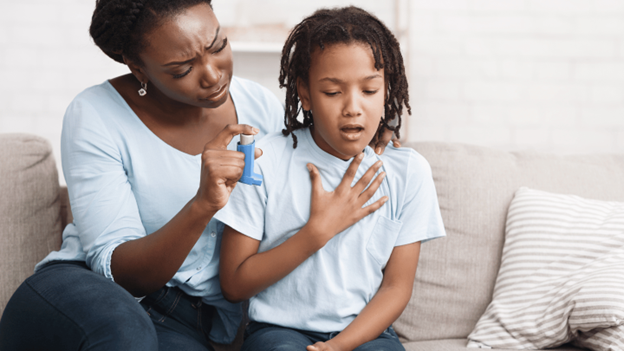
Asthma attack in kids: how to respond and when to get help.
Your child starts coughing and can't catch their breath. They're reaching for their chest and they start to panic. Is this a serious asthma attack you can handle at home, or do you need to get help fast?
Millions of children in the United States have asthma, making these scary moments all too common for families. While most asthma episodes can be managed at home, knowing when things turn serious could mean the difference between a quick recovery and a hospital visit.
The trick is spotting warning signs early and responding with the right approach.
Asthma attack symptoms: warning signs parents should know.
Recognizing asthma symptoms early helps you respond quickly.
Watch for these warning signs that progress from mild to serious.
Early asthma attack warning signs.
Increased coughing (especially at night), shortness of breath during normal activities and chest tightness that kids describe as feeling squeezed.
You might hear wheezing sounds when they breathe, though not all kids wheeze during attacks.
Behavior changes matter too. Your child might become unusually quiet, cranky, or tired for no obvious reason.
More serious asthma symptoms.
Trouble speaking in full sentences, fast or labored breathing and skin that looks bluish around the lips or fingernails.
Watch for pulling motions around the ribs or neck as they struggle to breathe.
Emergency warning signs.
Extreme difficulty breathing, blue or gray color that won't go away, panic about breathing, no improvement with a rescue inhaler, or inability to walk normally because breathing takes all their energy.
Breathing problems in kids can be worrying, whether it's asthma, allergies, or something else. Our health and wellness blog helps parents recognize symptoms and know when to seek care.
Asthma attack treatment: inhalers, medications and first aid.
Stay calm yourself. Kids can pick up on their parents’ anxiety, which makes breathing problems worse. Help your child sit upright in a comfortable position.
Never have them lie down during an attack.
Using rescue inhalers correctly.
Get their rescue inhaler immediately and follow these steps:
- Shake the inhaler well before use
- Use a spacer if available
- Have your child breathe out fully
- Press down while they breathe in slowly and deeply
- Wait 1-2 minutes between puffs if multiple doses are needed
After giving medication for an asthma attack.
Monitor improvement over the next 15-20 minutes. Symptoms should start getting better fairly quickly with proper medication.
Keep them calm and quiet while the medication works. Small sips of warm water are okay if they want them, but don't force anything.
What NOT to do during an asthma attack.
- Don't give too much medication too quickly
- Don't use expired inhalers
- Don't wait too long to get help if home treatment isn't working
When asthma attacks require urgent care vs. the emergency room.
- Handle at home. Symptoms are mild and respond well to a rescue inhaler within 15-20 minutes. Your child can speak normally and walk around after treatment and breathing returns close to normal.
- Emergency Room/911. Severe breathing difficulty that doesn't improve with medication, blue or gray coloring around the mouth or lips, extreme difficulty speaking, or signs of respiratory distress or/exhaustion from working hard to breathe/drowsiness
- Urgent care. Moderate symptoms that improve but don't disappear completely, frequent need for rescue inhaler over several days, or when you have concerns, but symptoms aren't severe.
Ultimately, most asthma attacks in kids respond well to proper treatment when caught early. When you're not sure whether to worry, it's always better to get it checked out.
At CityMD, we understand how terrifying asthma attacks can be for families. Our providers are experienced with childhood asthma and can quickly figure out whether your child needs immediate treatment or medication adjustments.
No appointment needed and we're here to keep your child breathing easier.

We’re ready to care for you.
Visit any CityMD urgent care location in your community today for an evaluation with one of our expert providers.